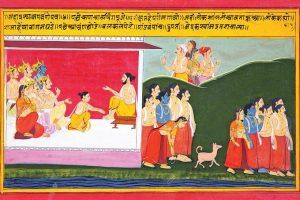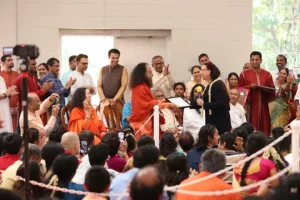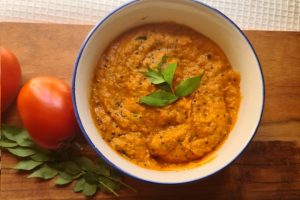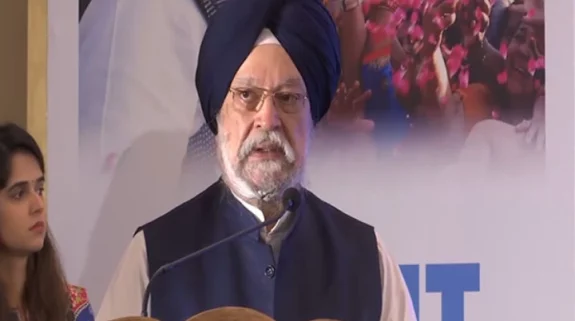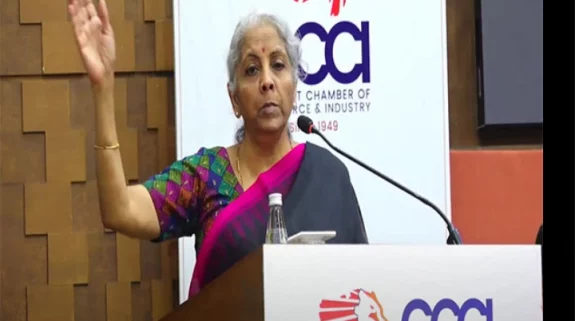At Shaharnama, a literary festival supported by Rajasthan Tourism and the Prabha Khaitan Foundation, where I was a speaker recently along with two of the leading lights of Indian restaurants, chef Manish Mehrotra of India Accent and Aditi Dugar, founder of Masque in Mumbai, an interesting theme came up for discussion—how Indian food’s perception internationally is shaped by how menus have been written and how its image has often been shaped by people with little grasp of its underlying principles.
A soulful beginning of #Shaharnama in #Jaipur this morning with #qawwali. pic.twitter.com/EHivaBQzV3
— Abhay K. (@theabhayk) February 19, 2023
Fanciful names for dishes such as “Kofta Shabnami” or “Dal Dilpasand” that were regular on generic Indian menus till a few years ago may have been a throwback to a more poetic past, when dominant culinary cultures of Delhi, Lucknow were inspired by nature to name their creations. However, as these dishes got commercial and started to feature in “Mughlai-meets-Punjabi” menus in restaurants not just within the country but “curry” (cooked by Bangladeshi cooks) and “balti” (nothing to do with the food of Baltistan) restaurants not even run by Indians in London, they became a code for just something spicy dunked in orange or brown “sauce” or curry.
Till today, this is the image of Indian food that persists globally even though more recently nuanced regional Indian food has begun to appear on menus not just within India but in London, New York and Milan too, where a new generation of Indian chefs are serving food that they have researched or grown up with and recipes that don’t fall into this trap of being random “curry” concoctions.
The curry stereotype is finally being rewritten by chefs such as Chintan Pandya in New York, whose Khad Khargosh, an old Rajput recipe involving cooking in pits, is quite the rage amongst gourmands, by Ritu Dalmia in Milan who serves kadhi in her restaurant and by the likes of Sameer Taneja in Benares, who makes periodic India trips to check out street food before turning it into fine dining at Benares, a Michelin starred restaurant in central London.
Best part of cooking? The smell that comes with good food!
Catch Chef #SameerTaneja alongside #HershaPatel this Sunday on #TheChef at 6pm on #SonyTVUK!
@Lord_Bilimoria #CobraBeer @#Chef #cooking #cook #food #foodie #cheflife #chefmode #foodstagram #foodlover @samsunguk pic.twitter.com/j9ItWWh9mq
— The Chef (@thechefonsony) February 26, 2020
Then, there is Gaggan Anand, the most popular Indian chef internationally, based in Bangkok, whose restaurants have featured as the best in Asia and amongst the top 10 in the world in prestigious lists, who is currently doing an old Delhi inspired menu at a month-long pop up in Delhi, where his most popular dishes such as Yogurt Explosion (a take on dahi in chaat) and Lick (you lick the plate!) now pay homage to the tradition of dona, or leaf plates (the yoghurt spherefication comes on an edible leaf now) and roasted shakarkandi of Delhi’s winters.
Celebrity chef Gaggan Anand to open his first official restaurant in Singapore on Oct 24 https://t.co/z9qWo0w2T5 pic.twitter.com/ZaP76ZLhSP
— CNA (@ChannelNewsAsia) October 5, 2022
Slowly but surely, Indian chefs are changing the perception of Indian food globally at the highest level though at a more mass level, the idea of “cheap curries” may still abides with large chunks of western populace. Even as these chefs bring more awareness about nuances of Indian cuisines on to the plate, let us discuss some of the principles of Indian gastronomy—what makes Indian food Indian, and also one of the most complex and diverse culinary cultures in the world.
The Ayurvedic basis to spicing, to seasonality—as we use certain ingredients at certain times of the year– and the fact that food has always been regarded as medicine or cooked for therapeutic benefits cannot be overlooked when it comes to any understanding of Indian cuisines.
Indian culinary culture in all its diversity has always had an underpinning in Ayurveda. Ayurveda forms the basis of spicing. If Indian food is all about nuanced and balanced spicing and that is what makes it both complex and unique, we cannot understand this without understanding the principles of Ayurveda. Even in medieval India, unani medicine (influenced by Ayurveda and the Greek system of medieval medicine) forms the basis of spicing in Mughlai, Nawabi and Nizami cuisines; when highly paid cooks used fantastic ingredients like pearl or gold bhasm or ash in their spice mixes, it was in the belief that they gave vitality to the royals for who these dishes were concocted.
In India, though packaged garam masala is now available 24X 7 and used liberally even in homes in dishes which don’t need it, a differing uses of garam and thanda masalas has always been prevalent in Indian gastronomy.
Warming and cooling spices, as deemed by Ayurveda, were used in winter and summer dishes to enhance or soothe “agni” or the digestive power within us that changes according to seasons —it is at a high in summer, the hot season of the subcontinent, and at a low in winter. Thus spicing in food needs to be adjusted accordingly—the use of warming spices in winter provokes agni, and cooling spices in summer to soothe the system.
This is putting it in highly simplistic terms and there are many more nuances including a customisation of diets according to individual needs —which doshas need to be balanced, according to the body “type” of an ingredient, the property of the ingredients themselves, and also how to combine ingredients and spices to balance the tastes—sweet, sour, bitter, astringent and pungent.
The spice combinations that are used with specific vegetables, daals and meats are based on these principle of balancing doshas and gunas, as per Ayurveda, that is so much a part of Indian kitchen lore that it has become part of many oral traditions as “dadima ke nuskhe” (granny’s knowledge).
दादी मां के नुस्खे : बहुपयोगी है सोंठ https://t.co/YJlRz3aD8i#healthcare #ayush #dadimakenuskhe pic.twitter.com/33VhE2b5US
— Prarabdh News (@NewsPrarabdh) June 28, 2021
Karela, or bitter gourd, a summer vegetable, for instance, is spiced with the sour amchoor or dried mango powder and “saunf” or fennel with its sweet notes, to make a balanced dish that is also good for summer because of the digestive properties ascribed to fennel, and the astringent bitter gourd that is in season this time of the year.
Heavier meats are winter dishes and cooked with “warming” spices now dubbed garam masala and used generically in all seasons and for little reason in urban Indian kitchens. Fish meanwhile with mustard and poppy seeds paste was considered lighter and eaten in summer months too, the thanda masala supposedly soothing the stomach. Rai, the “Indian mustard” as it is dubbed, is an ingredient widely used is fermented around spring, to also promote good gut—in Kanji, the quintessential Holi drink, and in achars or pickles.
Thanda Masala – A Spice Mix http://t.co/dnN3W4ZCqz #new_post pic.twitter.com/Ws2uD830Vk
— Food Frenzy Digest (@food_frenzy) April 29, 2014
Most Indians while cooking at home use these spices in a seasonal way instinctively because they may have seen older generations do the same. But this complex body of knowledge is slipping away today and needs to be revived if Indian culinary cultures are to be understood in any depth.
While the diversity of Indian cuisines is because of a diversity in spicing as also because of how souring agents change every few 100 kilometers—so that the same fish cooked with tamarind may be quite different from one cooked with kokum or dried mango of the north, the diversity of greens, of hyperlocal seafood along the long coastline and even of grains that form the staple in most diets is mind boggling too.
While most people assume that staples such as rice don’t change, even a grain such as this—the very basis of civilisation, regarded as akshat, giving long life and prosperity, in many rituals, is hardly homogenous. Instead of basmati, the long grained variety, that is thought to have been brought to the terai regions by the Afghans exiled to the mountains of Uttarakhand by the British, local rice varieties are found in every region of the country—ambe mohur of Maharashtra, tilak chandan of UP, the jeera samba of the south with its small (literally cumin like grain), and the gobind and gopal bhog of eastern Indian are all enjoying a period of increased interest after years of having been subsumed by the basmati cult.
Improved Paddy Gopal Bhog is a short and scented rice. It is suitable for Midland/Upland Cultivation. It is also en extremely high yielder.#farming #vegetables #agriculture #crops #field #healthylifestyle #healthyfood #india #agricultureindia #hybridpaddy #paddy pic.twitter.com/0ZsJSaz0rb
— Ramnagar Seed Farm (@Ramnagar_seed) July 4, 2022
But many others are lost—as also the notion of seasonality even in grain. In ancient India, shali or rice had various categories—depending on when it was sown and harvested, and each was attributed its own health benefits. Of this the winter harvested “mahashali” was deemed the best rice.
With millets too that grow all over India, seasonal patterns were observed—bajra, a warming grain, is typically eaten in winter, while jowar is summer appropriate and so on. A separate column on these will follow.
If the diversity and seasonality of Indian cuisines and their underpinning in Ayurveda is essentially to understand for any understanding of Indian food, the idea that often, a common strain of cooking runs through the subcontinent because of cultural connections also needs to be understood and documented.
Many mithais are common to different parts of the country and the idea of mithai itself is uniquely Indian. Dishes like patode/pathrode/aluchi vadi all an ancient Indian dish of colocasia leaves rolled up in a besan batter and fried are to be found through the length of the country. And then there is paan— from Benares to Kerala and Assam, this leaf, widely seen as auspicious too, ends meals—and was so much a part of Indian food and hospitality that virtually every foreign traveller or visitor to India has noted its wide use.
What is Indian food, and how do we successfully communicate it to the rest of the world in all its complex glory, and without reducing it to the status of “curry” must per force necessitate an understanding of all these “basics” in depth.
Also Read: How colonial Britain bungled in viewing diverse Indian cuisine as a mere ‘curry’
(Anoothi Vishal is the author of Mrs LC’s Table. She is also a columnist and food writer, specialising in cuisine history, culinary links between communities and regions. Views expressed are personal and exclusive to India Narrative)








